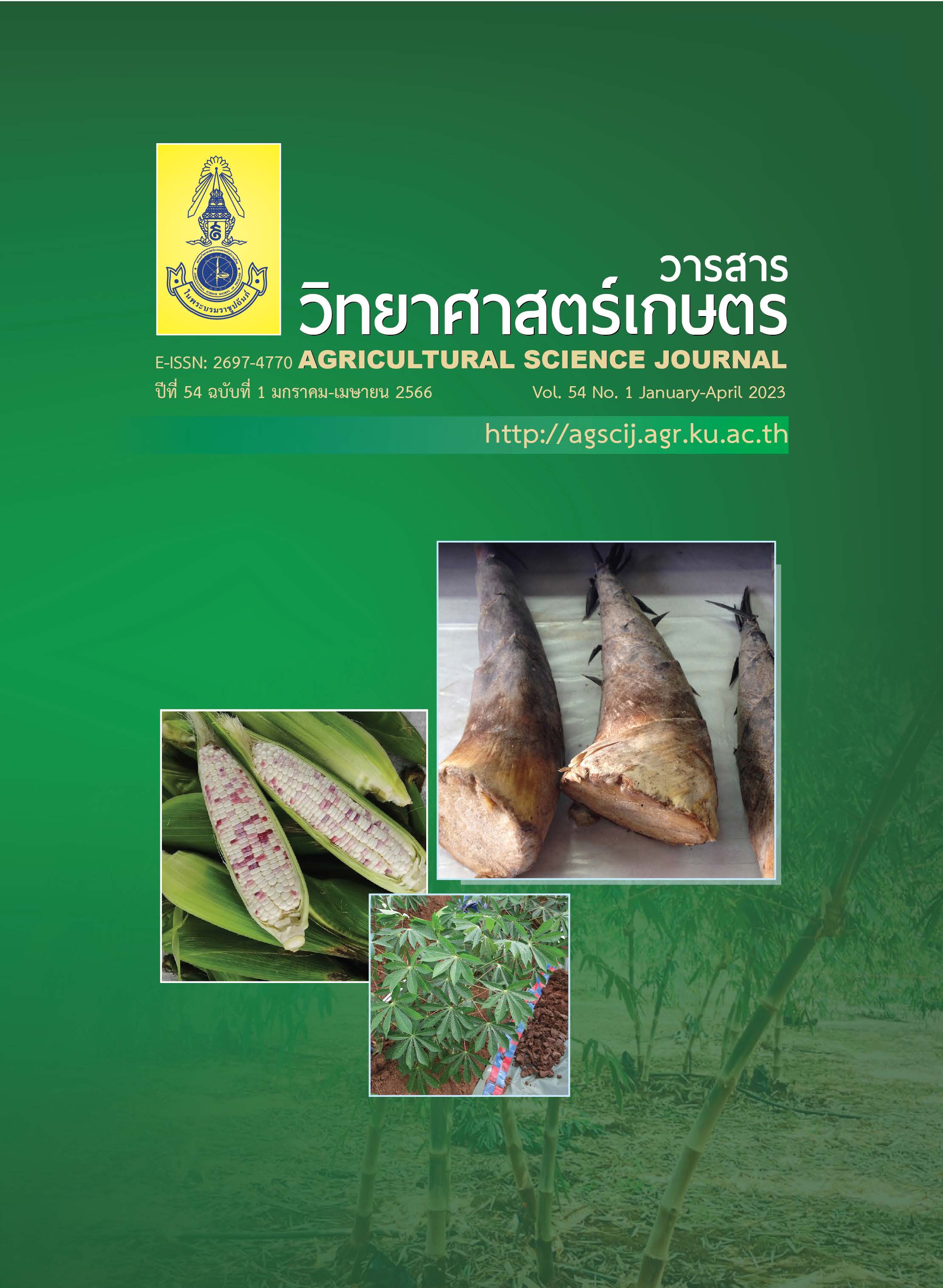อิทธิพลของความลึกการไถพรวนดินและความลึกการหยอดเมล็ดต่อการเจริญเติบโตของข้าวในสภาวะแห้งแล้ง
Main Article Content
บทคัดย่อ
ข้าวนาปีเมื่อเผชิญกับสภาวะแล้งและฝนทิ้งช่วง มักประสบปัญหาด้านการเจริญเติบโตและผลผลิตลดลง การทดลองนี้มีวัตถุประสงค์เพื่อศึกษาอิทธิพลของความลึกการไถพรวนดิน และความลึกการหยอดเมล็ดต่อการเจริญเติบโตของข้าวในสภาวะแห้งแล้ง โดยปลูกข้าวพันธุ์ปทุมธานี 1 ในดินร่วนปนทรายของอำเภอโคกสำโรง จังหวัดลพบุรี วางแผนการทดลองแบบ 6 x 2 x 3 แฟคทอเรียลในแผนการทดลองแบบสุ่มสมบูรณ์ ภาวะความแห้งแล้งถูกจำลองโดยกำหนดรอบความถี่การให้น้ำต่างกัน 6 ระดับ (W; 2 5 10 15 20 และ 25 วัน) ร่วมกับปัจจัยทางเขตกรรมสองปัจจัย คือ 1) ความลึกการเตรียมดิน 2 ระดับ (D; 25 และ 40 เซนติเมตร) และ 2) ความลึกการหยอดเมล็ด 3 ระดับ (S; 0 2.5 และ 5.0 เซนติเมตร) และ วิธี Decision matrix ถูกนำมาประยุกต์เพื่ออธิบายผลการทดลอง ผลการศึกษา พบว่า ปัจจัยด้านเขตกรรมมีอิทธิพลต่อการเจริญเติบโตของข้าวทั้งในสภาวะแล้งและสภาวะปกติ ซึ่งอธิบายได้จากการแตกกอ จำนวนเมล็ดดีหรือเมล็ดลีบต่อรวง น้ำหนัก 100 เมล็ด น้ำหนักเมล็ดดีต่อกระถาง เปอร์เซ็นต์เมล็ดดีต่อรวง ดัชนีการเก็บเกี่ยว น้ำหนักรากแห้ง น้ำหนักฟางแห้ง และปริมาณการใช้น้ำที่แตกต่างกันระหว่างทรีตเมนต์ (P < 0.05) โดยเมื่อปริมาณน้ำลดลง ทรีตเมนต์ที่ 11 (W2D2S2; 5 วัน 40 เซนติเมตร 2.5 เซนติเมตร) ให้คะแนนการตัดสินใจในบันทึกข้อมูลตัวแปรตามการเจริญเติบโตใกล้เคียงกับชุดควบคุม (W1D1S1; 2 วัน 25 เซนติเมตร 0 เซนติเมตร) มากที่สุด และทรีตเมนต์ที่ 6 (W1D2S3; 2 วัน 40 เซนติเมตร 5 เซนติเมตร) ให้ค่าคะแนนดีที่สุดเมื่อเปรียบเทียบกับทรีตเมนต์อื่น ระดับความลึกการเตรียมดินและความลึกการหยอดเมล็ดที่เหมาะสม คือ 40 และ 2.5 เซนติเมตร ตามลำดับ ทั้งนี้ ระดับความลึกที่เพิ่มขึ้นมีอิทธิพลช่วยส่งเสริมการเจริญเติบโตและเพิ่มประสิทธิภาพการใช้น้ำทางด้านผลผลิตเมื่อข้าวเผชิญกับสภาวะแล้งได้ดีขึ้น
Article Details

This work is licensed under a Creative Commons Attribution-NonCommercial-NoDerivatives 4.0 International License.
References
Banpajan, N. 2001. Effects of Organic Matters and Plowing Depths on Soil Salinity and Yield of Dixie Grass (Sporobolus virginicus) Grown on Northeastern Saline Soil. MS Thesis, Khon Kaen University, Khon Kaen. (in Thai)
Buakum, B. 2011. Effects of Sowing Depths on Growth and Rooting Patterns of Legume in the Dry Season of Rainfed Area. PhD Thesis, Khon Kaen University, Khon Kaen. (in Thai)
Chantron, P. 1983. Growing Peanut after Rice in Paddy Field without Irrigation. MS Thesis, Khon Kaen University, Khon Kaen. (in Thai)
Donald, C.M. and J. Hamblin. 1976. The biological yield and harvest index of cereals as agronomic and plant breeding criteria. Adv. Agron. 28: 361–405.
Hsiao, T.C., J.C. O’toole, E.B. Yambao and N.C. Turner. 1984. Influence of osmotic adjustment on leaf rolling and tissue death in rice (Oryza sativa L.). Plant Physiol. 75(2): 338–341.
Kong-in, J. 2002. Effect of Organic Matter and Plowing Depth on Number of Nitrifying Bacteria and Yield of Dixie Grass (Sporobolus virginicus) Grown on Northeastern Saline Soil. MS Thesis, Khon Kaen University, Khon Kaen. (in Thai)
Kumar, A., J. Bernier, S. Verulkar, H.R. Lafitte and G.N. Atlin. 2008. Breeding for drought tolerance: direct selection for yield, response to selection and use of drought-tolerant donors in upland and lowland-adapted population. Field Crops Res. 107(3): 221–231.
Lamb, K.E. and B.L. Johnson. 2004. Seed size and seeding depth influence on canola emergence and performance in the Northern Great Plains. Agron. J. 96(2): 454–461.
Liu, J.X., D.Q. Liao, R. Oane, L. Estenor, W.E. Yang, Z.C. Li and J. Bennett. 2006. Genetic variation in the sensitivity of anther dehiscence to drought stress in rice. Field Crops Res. 97(1): 87–100.
Mahdi, L., C.J. Bell and J. Ryan. 1998. Establishment and yield of wheat (Triticum turgidum L.) after early sowing at various depths in a semi-arid Mediterranean environment. Field Crops Res. 58(3): 187–196.
Meenok, P. 2001. The Influence of Watering on Growth Yield and Water Consumption of 2 Varieties of Sugarcane in the Northeast. MS Thesis, Khon Kaen University, Khon Kaen. (in Thai)
Na Nagara, T. 1983. Soil - water and plant relationships. Thai Agric. Res. J. 1: 185–195. (in Thai)
Na Nagara, T., M.L.C. Tongyai and P. Ratanapradipha. 1984. Growth and water use of corn as affected by tillage practices and irrigation frequency. Thai Agric. Res. J. 2: 10–15. (in Thai)
Office of Agricultural Economics. 2016. Agricultural Statistics of Thailand. Ministry of Agriculture and Cooperatives, Bangkok, Thailand. (in Thai)
Polthanee, A. 1991. Cultivation of peanuts after rice in rainfed areas of northeast Thailand: farmers’ approach. Thai J. Agric. Sci. 7(1): 70–76. (in Thai)
Rasmussen, W.W., D.P. Moore and L.A. Alban. 1972. Improvement of a solonetzic (slick spot) soil by deep plowing, subsoiling, and amendments. Soil Sci. Soc. Am. J. 36(1): 137–142.
Royal Irrigation Department. 2011. Crop Water Requirement Reference Crop Evapotranspiration and Crop Coefficient Handbook. Irrigation Water Management Division, Royal Irrigation Department, Bangkok, Thailand. (in Thai)
Schillinger, W.F., E. Donaldson, R.E. Allan and S.S. Jones. 1998. Winter wheat seedling emergence from deep sowing depths. Agron. J. 90: 582–586.
Siddique, K.H.M. and S.P. Loss. 1999. Studies on sowing depth for chickpea (Cicer arietinum L.), faba bean (Vicia faba L.), and lentil (Lens culinaris Medik) in a Mediterranean-type environment of south-western Australia. J. Agron. Crop Sci. 182(2): 105–112.
Sitthisuntikul, K., B. Jolanun and P. Yossuk. 2015. Alternatives for adapting rice farming to drought of On Tai farmers, San-Khampaeng district, Chiang Mai province, pp. 1241–1248. In Proc. the 53rd Kasetsart University Annual Conference, 3–6 February 2015. (in Thai)
Slatyer, R.O. 1967. Plant Water Relationships. Academic press, Inc., London, UK.
Stucky, D.J. 1976. Effect of planting depth, temperature, and cultivars on emergence and yield of double cropped soybeans. Agron. J. 68(2): 291–294.
Sun, J.K., T. Li, J.B. Xia, J.Y. Tian, Z.H. Lu and R.T. Wang. 2011. Influence of salt stress on ecophysiological parameters of Periploca sepium Bunge. Plant Soil Environ. 57(4): 139–144.

